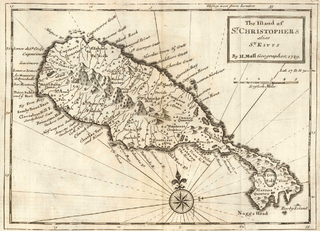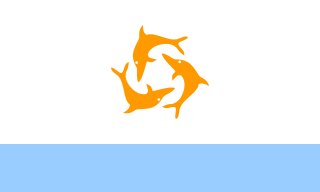Related Research Articles

Anguilla is a British Overseas Territory in the Caribbean. It is one of the most northerly of the Leeward Islands in the Lesser Antilles, lying east of Puerto Rico and the Virgin Islands and directly north of Saint Martin. The territory consists of the main island of Anguilla, approximately 16 miles long by 3 miles (5 km) wide at its widest point, together with a number of much smaller islands and cays with no permanent population. The territory's capital is The Valley. The total land area of the territory is 35 square miles (91 km2), with a population of approximately 15,753 (2021).

Caribbean cuisine is a fusion of West African, Creole, Amerindian, European, Latin American, Indian/South Asian, Middle Eastern, and Chinese. These traditions were brought from many different countries when they came to the Caribbean. In addition, the population has created styles that are unique to the region.

Nevis is a small island in the Caribbean Sea that forms part of the inner arc of the Leeward Islands chain of the West Indies. Nevis and the neighbouring island of Saint Kitts constitute the Federation of Saint Kitts and Nevis, a singular nation state. Nevis is located near the northern end of the Lesser Antilles archipelago about 350 kilometres (220 mi) east-southeast of Puerto Rico and 80 kilometres (50 mi) west of Antigua. Its area is 93 square kilometres (36 sq mi) and the capital is Charlestown.

Saint Kitts and Nevis, officially the Federation of Saint Christopher and Nevis, is an island country and microstate consisting of the two islands of Saint Kitts and Nevis, both located in the West Indies, in the Leeward Islands chain of the Lesser Antilles. With 261 square kilometres (101 sq mi) of territory, and roughly 50,000 inhabitants, it is the smallest sovereign state in the Western Hemisphere, in both area and population, as well as the world's smallest sovereign federation. The country is a Commonwealth realm, with Charles III as King and head of state. It is the only sovereign federation in the Caribbean.

Saint Kitts and Nevis have one of the longest written histories in the Caribbean, both islands being among Spain's and England's first colonies in the archipelago. Despite being only two miles apart and quite diminutive in size, Saint Kitts and Nevis were widely recognized as being separate entities with distinct identities until they were forcibly united in the late 19th century.

Saint Kitts, officially Saint Christopher, is an island in the West Indies. The west side of the island borders the Caribbean Sea, and the eastern coast faces the Atlantic Ocean. Saint Kitts and the neighbouring island of Nevis constitute one country: the Federation of Saint Kitts and Nevis. Saint Kitts and Nevis are separated by a shallow 3-kilometre (2 mi) channel known as "The Narrows".

The British West Indies (BWI) were colonised British territories in the West Indies: Anguilla, the Cayman Islands, Turks and Caicos Islands, Montserrat, the British Virgin Islands, Antigua and Barbuda, The Bahamas, Barbados, Dominica, Grenada, Jamaica, Saint Kitts and Nevis, Saint Lucia, Saint Vincent and the Grenadines, British Guiana and Trinidad and Tobago. Other territories include Bermuda, and the former British Honduras. The colonies were also at the centre of the transatlantic slave trade, around 2.3 million slaves were brought to the British Caribbean. Before the decolonisation period in the later 1950s and 1960s the term was used to include all British colonies in the region as part of the British Empire. Following the independence of most of the territories from the United Kingdom, the term Commonwealth Caribbean is now used.

The coat of arms of Anguilla is the heraldic device consisting of a shield charged with three orange dolphins leaping over the sea. Adopted in 1990, it has been the coat of arms of Anguilla since that year. The escutcheon is featured on the flag of the territory.

Saint Christopher-Nevis-Anguilla was a British colony in the West Indies from 1882 to 1983, consisting of the islands of Anguilla, Nevis, and Saint Christopher. From 1882 to 1951, and again from 1980, the colony was known simply as Saint Christopher and Nevis. Saint Christopher and Nevis gained independence in 1983 as the Federation of Saint Kitts and Nevis, while Anguilla would remain a British overseas territory.
James Ronald Webster (2 March 1926 – 9 December 2016) was a politician from Anguilla. After ending the Saint Christopher-Nevis-Anguilla federation in 1967, he served as the island territory's first Chief Minister from 10 February 1976 to 1 February 1977 and again from May 1980 to 12 March 1984.
West Indies Associated States was the collective name for a number of islands in the Eastern Caribbean whose status changed from being British colonies to states in free association with the United Kingdom in 1967. These states were Antigua, Dominica, Grenada, Saint Christopher-Nevis-Anguilla, Saint Lucia, and Saint Vincent.
Sir Thomas Warner was a captain in the guards of James I of England who became an explorer in the Caribbean. In 1620 he served at the brief-lived English settlement of Oyapoc in present-day Guyana of South America, which was abandoned the same year. The Dutch controlled most of the territory. Warner is noted for settling on Saint Kitts and establishing it in 1624 as the first English colony in the Caribbean.

The following outline is provided as an overview of and topical guide to Saint Kitts and Nevis:

The Republic of Anguilla was a short-lived, unrecognised independent state on the island of Anguilla. It lasted from 11 July 1967 until 19 March 1969, when British control was re-established.
Afro-Anguillians or Black Anguillians are Anguillian whose ancestry lies within the continent of Africa, most notably West Africa.

Saint Kitts and Nevis and the United Kingdom have a long history of colonial activity and later diplomatic relations.
Patricia J. Adams is an Anguillan writer and former teacher. An annual award which bears her name is given each year by the Department of Education to the primary students in grades 3, 5, and 6 who excel in creative writing. She was the recipient of the Queen's Certificate and a badge of honour in 2012 on Anguilla Day.

The primary law governing Saint Kitts and Nevis nationality regulations is the Saint Christopher and Nevis Citizenship Act, which came into force on 28 February 1984.
Operation Sheepskin was a British military operation in the Caribbean, aimed at restoring British rule to the island of Anguilla, after the island had declared itself as an independent Republic. The British government dispatched two Royal Navy ships and 300 soldiers of the 2nd Battalion, Parachute Regiment and 22 officers of the Metropolitan Police to restore order to the island. The operation was a success and British troops were met with no resistance by the islanders, as they had wanted the island to remain a British territory but with direct association with Great Britain, separate from Saint Kitts and Nevis, of which they were a part.
References
- 1 2 3 4 5 6 7 8 9 10 11 12 13 14 15 16 17 "Anguilla's History". The Anguilla House of Assembly Elections. Government of Anguilla. 2007. Archived from the original on 2007-08-13. Retrieved 9 June 2015.
- ↑ "Anguilla's Precolumbian History". The Anguilla Guide. 2003. Archived from the original on 2005-08-27.
- ↑ Hakluyt (1904), p. 5.
- ↑ "Anguilla". Atlas of Mutual Heritage (in Dutch).
- ↑ Mitchell, Don (May 12, 2017). "Anguilla's Judicial System, 1650-2017" . Retrieved 16 May 2016.
- 1 2 3 4 5 6 Martin (1839), p. 102.
- ↑ Roche (2005), p. 145.
- 1 2 EB (1878), pp. 46–47.
- 1 2 EB (1911), pp. 42–43.
- ↑ "Anguilla goes back to union". The Modesto Bee . August 1, 1967. Retrieved June 5, 2012.
- ↑ "Anguilla levels warning at force". The News and Courier . August 12, 1967. Retrieved June 5, 2012.
- ↑ Berrellez, Robert (September 9, 1967). "Anguilla seeks permanent ally". The Leader-Post . Retrieved June 5, 2012.
- ↑ Fodor's in Focus St. Maarten, St. Barths & Anguilla (1st ed.). Fodor's. 2008. p. 110. ISBN 978-1-4000-0758-5.
Bibliography
- Baynes, T. S., ed. (1878), , Encyclopædia Britannica , vol. 2 (9th ed.), New York: Charles Scribner's Sons
- Chisholm, Hugh, ed. (1911), , Encyclopædia Britannica , vol. 2 (11th ed.), Cambridge University Press
- Dyde, Brian (2005). Out of the Crowded Vagueness . Macmillan Education. ISBN 0-333-97598-7.
- Hakluyt, Richard (1904). "The second voyage unto Florida, made and written by Captaine Laudonniere, which fortified and inhabited there two Summers and one whole Winter". The Principal Navigations, Voyages, Traffiques, & Discoveries of the English Nation Made by Sea or Over-land to the Remote and Farthest Distant Quarters of the Earth at any time within the compasse of these 1600 Yeeres, Vol. IX Made to Florida and New Mexico; certeine Voyages made for the discovery of the Gulfe of California, and to the famous city of Mexico, with the Discourses and Letters depending upon the Voyages of this ninth Volume. Glasgow: James MacLehose & Sons.
- Martin, Robert Montgomery (1839). "Chapter XIV.—Anguilla.". Statistics of the Colonies of the British Empire in the West Indies, South America, North America, Asia, Austral-Asia, Africa, and Europe; comprising the Area, Agriculture, Commerce, Manufactures, Shipping, Custom Duties, Population, Education, Religion, Crime, Government, Finances, Laws, Military Defence, Cultivated and Waste Lands, Emigration, Rates of Wages, Prices of Provisions, Banks, Coins, Staple Products, Stock, Moveable and Immoveable Property, Public Companies, &c. of Each Colony; with the Charters and the Engraved Seals. From the Official Records of the Colonial Office. London: William H. Allen & Co.
- Petty, Colville (1984). Anguilla: Where There's a Will There's A Way. East End, Anguilla: C.L. Petty.
- Roche, Jean-Michel (2005). Dictionnaire des bâtiments de la flotte de guerre française de Colbert à nos jours (in French). Vol. 1. Group Retozel-Maury Millau. ISBN 978-2-9525917-0-6. OCLC 165892922.
- Sekou, Lasana M., ed. (2015). Where I See The Sun – Contemporary Poetry in Anguilla. Philipsburg, Sint Maarten: House of Nehesi Publishers. ISBN 978-0-99622-420-8.